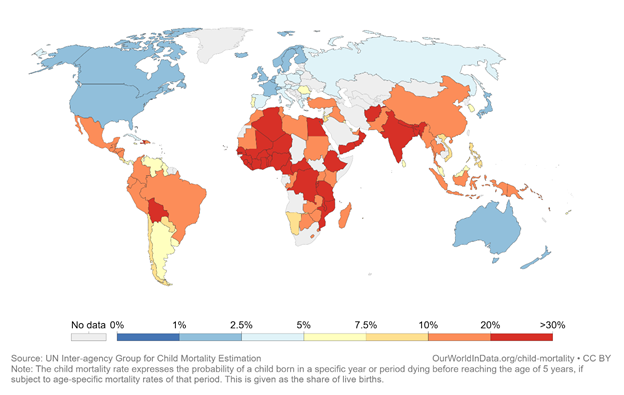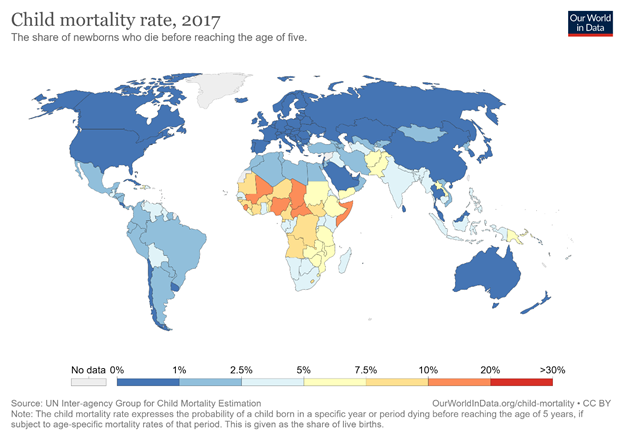
Making the Hardest Decisions
- Shubhankar Nath
- Science
- August 9, 2020

Allow me to show you a world in some color. This is a representation of Child Mortality rate around the world. Child Mortality rate is defined by the number of children who die under the age of five per 1000 live births. Try to imagine this – If you were born in India you would share your birthday with 49,000 (rounded up) other babies of your country, and out of them 14,000, will never be able to light more then five candles on their birthday cake.
A lot of this deaths are due to the inability of medical infrastructure and decisions. The story of a wrongful medical decision taking a life is not unheard of. Medical errors are the third-leading cause of death among Americans after heart attacks and cancer. These decisions are often not perfectly solvable – risk on both fronts. I hope you never need to take a medical decision in your life, but we all know that is a fantasy. But in case you have to, how well quipped are you? Are going to make informed strategic decisions or roll a dice? Here are a few things that will be very useful.
Thinking straight about probability
If there was no uncertainty, decisions would be easy! The uncertainty exists because we do not know what future will unveil due to our decision. Cognitive Science has proven that relying on our gut or intuition is not always the best device. You can always rely on your knowledge of statistics for this.
If you buy one out of one million lottery ticket sold, your winning chances are one in a million. You can increase your chance of winning the lottery by a hundred times just by buying hundred tickets but it will have no real-world significance, as your winning chance will still be 1 in 100,000 which is pretty thin. You might read that accepting a particular treatment might reduce the chance of getting a disease by 50% but if you had only 1 in 100,000 chance of getting it anyway, it might not be worth the treatment. We live in a world of 7 billion and with such a large number these small percentages tend to get significance – this is called law of large numbers.
Doctors often refer in subjective probabilities – which are neither calculable not countable but just expresses their subjective confidence in the matter for example – ‘There is a 60% chance that one rogue nation will fire an nuclear weapon in this century.’ Humans have a poor sense of what constitutes a random sequence, if asked we tend to write down far more alterations of ‘head-tails-head-tail’ and far fewer runs of ‘heads-heads-heads-heads’. This is because we think that probabilities tend to change on subsequent events, they do but not for independent events. If you are a hunter-gathering and you are looking for a fruit you ate last summer in the valley, each land area you search increases your chance of finding it in the next search – this search is a dependent event. To demonstrate this, researchers set up a university party scenario where 10% students were Engineers and 90% were not – and then explain: “You run into someone who might be wearing a plastic pocket protector or not but you cannot tell as he has a jacket on”. When asked to rate the probability that he is an engineer or not, people typically answered “Fifty-fifty”.
You just tested - Positive
Let’s say you wake up with a blurred vision one morning. You googled it up and found that it could be blurritis. You took a blood test for it and it turns out to be positive – How serious is this? The cure is a medication called cholorohydroxelene which has a 5% chance of serious side effect – itching in your back. You can take medication for itching but it has an 80% chance of shooting up your blood pressure? How should you take a decision here?
The four-fold table is a easy way to visualize the information and does not require more than elementary level maths. Let’s gather few information about blurritis and proceed.
- Base rate for blurritis : 0.0001
- Cholorohydroxelene side effect base rate : 0.05
The base rate of Blurritis tells that one selected at random between 10,000 might have the disease, but you are not anyone random – You tested positive! But most tests do not work that way – they are imperfect. So you need one more piece of information – what percentage of the time the test is wrong? It can be wrong in two ways, False positive – it can indicate you have the disease when you don’t or False negative – it can indicate you do not have the disease when you do.
- Error rate of False positive – 2% (say)
- Error rate of False negative – 2% (say)
Equipped with the above we arrive ultimately with two variable which can have binary (two states) values in each. Disease – have / have not & Test Result – positive / negative.
|
Test Result |
||||
|
Disease |
|
Positive |
Negative |
Totals |
|
Have |
1 |
0 |
1 |
|
|
Have not |
200 |
9,799 |
9,999 |
|
|
Totals |
201 |
9,799 |
10,000 |
|
From the above table it is easy to visualize that out of 10,000 people, 201 of them had tested positive just like yours but only 1 actually had the disease. So even after testing positive and increasing your chances from 1 in 10,000 to 1 in 201, you only have a slim (1/201 x 100) 0.49% likelihood to being ill with blurritis.
Lets extend the understanding a little further with the Miracle drug – Cholorohydroxelene! The 5% side effect rate is not atypical from real medication numbers. This means for every 201 people who take the drug only 1 of them will experience the cure (because the other did not have it in the first place) and 10 will have to suffer irresistible back itches. So if you take the drug you are 10 times more likely to suffer from it rather than to get relieved.
Neurons that scream Safe
An estimated 2.5 million men in US alone have prostate cancer and 3% of men will die from it. This number worldwide is so large that it sparked a ‘No shave November’ movement to generate awareness for it. It is the second leading cause of cancer death among men after lung cancer. Nearly every urologist who delivers the news will recommend radical surgery to remove the prostate. And of first blush it sounds reasonable too – sacrifice a small portion of your body instead and live to see more days.
But it is not so simple if you get to know about it. For one, it is a particularly slow - progressing cancer, most men die with it rather than of it. There is also a high incidence of recurrence following surgery. And what about the side effects? The incidence rates of side effects among patients after surgery is as follows –
- Inability to maintain erections – 80%
- Shortening of phallus by one inch – 50%
- Urinary inconsistence – 35%
- Fecal inconsistence – 25%
- Hernia 17%
Just reading a few out of the lot makes one feel awful. But still a lot of men when faced with the choice will go for the surgery as it is better than death. But can it be safely left untreated in men? If yes, then how many men? 47 out of 48. To put into another way, for every 48 prostate surgeries performed only 1 life is extended and the other 47 who would have lived just as long anyway, now has to suffer the side effects.
So then why nearly every urologist recommends the surgery? It is one of the most complicated surgeries known, is it not a good reason not to recommend it? But the fact is they have invested an enormous amount of time and money in learning it. The training required is extensive and those who have mastered it are prized for the rare skill. They are trained in removing the cancer not to look at the quality of life after. And when you are have a hammer, everything starts to look like a nail.
Nevertheless, the C word is very intimidating. It is very hard for a patient who is diagnosed with cancer to listen to the statement “We will just keep an eye on it” from the doctor, they feel they were not taken care properly. Also the fact that our brains are wired to react to Risks with greater coefficients and not rationally. This bias is called loss aversion. What if you are the 1 among the 48? Is there any telling? That’s what your neurons will scream.
Alternative treatments
In India Homeopathy is over a 1,000 crore industry with a growth rate of 15-20 % annually. It is a 19th century practice which revolves around two principles – one that the substance that actually is the cause of the disease can cure it if administered in small doses. The second belief is that diluting a substance repeatedly leave the remnants of the original substance with better ‘vibrations’ and has curative properties. The more dilute the substance, the more powerful it is.
The dilution though goes through a very specific procedure – the technician takes one part of the chemical substance and dilutes it with ten parts of water and then shakes it up and down ten times, back and forth ten times and side to side ten times. Then he takes one part of that solution and dilutes it in ten parts of water and repeats the shaking procedure again. The repetition is performed twenty times or so resulting in a solution which is one part of the original substance to 100,000,000,000,000,000,000 parts of water. For retail products the dilutions are routinely 1 followed by 30 zeros and often 1 followed by – get this – 1,500 zeros. This is very gargantuan number, it is like taking a grain of rice and crushing it into a fine powder and dissolving it in a sphere of water the size of our solar system – and yeah repeating that 26 times. Ever wondered why all homeopathic medicines taste same ?
Homeopathy is not the only candidate – the Multi-vitamin industry, herbal product industry is all the same. Our body is perfectly equipped to fight a lot of common diseases on its own – it has survived generations evolving and taking some of the alternative medicines cause no effect to it. There is a reason they are called ‘alternative treatments’, if they could be proven effective they would be called just ‘Medicines’. And that is why all clinical trials go through a double blind randomized test where the people who have taken the pill must show better results than the people who have taken the fake pill. Also we have the placebo effect and it is really very strong. It is so powerful that it is the only known treatment for some migraines. If people just believed that a sugar syrup will cure them - it cured them more often then not.
Takeaways
- Evaluate numbers in terms of their real-world significance.
- Knowing the error rates and base rates are important while making decisions.
- Use the four-fold table method to make decisions.
- Know that our instinct is to be loss averse not rational.
- You can have a equal partners relationship with your doctor rather than a parent – child relationship.
- The world is not doing that bad too, the world map was from 1969. This is how the world looks now:

References
- https://www.cancer.org/healthy/find-cancer-early/mens-health/cancer-facts-for-men.html
- https://www.ncbi.nlm.nih.gov/pmc/articles/PMC3505292/
- The Organized Mind by Daniel J. Levitin


